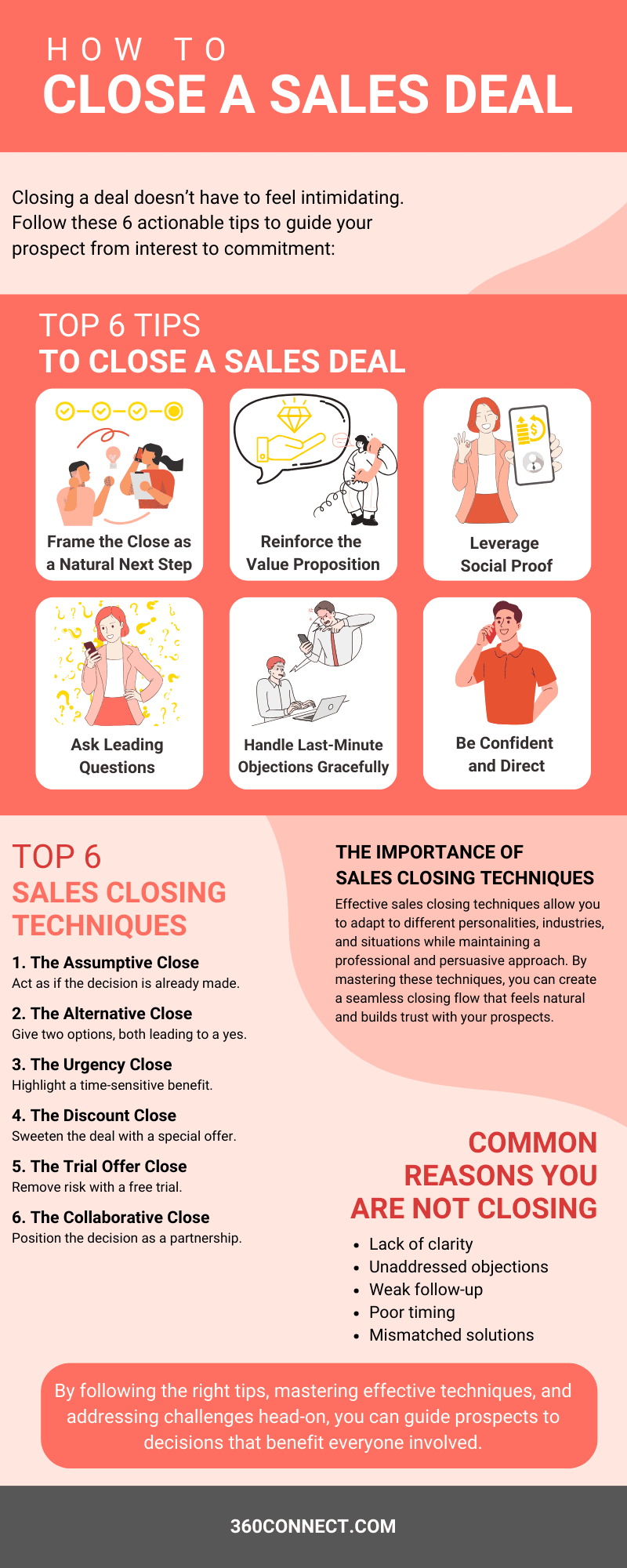You’ve built the relationship, they’ve shown genuine interest, all that’s left to do is close the deal. You can see the finish line (and commission) already! However, slow your roll, because as you are aware or as any salesperson can tell you, mastering how to close a sales deal is no easy feat.
Closing a sales deal can feel like the ultimate challenge in the sales process. Even if you’ve nailed the sales call and addressed your prospect’s needs, the final conversations can determine whether all your hard work pays off. But don’t worry—closing is a skill that anyone can learn with practice and the right guidance.
In this blog, we’ll be going over a practical and applicable guide on how to close a sales deal that can help you boost your sales goals.
Related: If you’re still mastering the art of the sales call, check out our blog How to Make a Sales Call for tips to set the foundation for success.

How to Close a Sales Deal
Closing a deal doesn’t have to feel intimidating. Follow these 6 actionable tips to guide your prospect from interest to commitment:
1. Frame the Close as a Natural Next Step
The best tip we can give is to frame the close as a natural next step. Closing shouldn’t feel like a separate event but a continuation of your conversation. To do this, use language that positions the close as the next logical step in solving their problem.
For example, “Based on what we’ve discussed, it sounds like _____ is exactly what you need! If this sounds right, we can move forward and proceed with _____.”
By framing the close as a natural next step, closing becomes easier. When you abruptly stop the conversation and state things like “Let’s setup a call to close the deal” this adds more time. More time for the prospect to change their mind or stop responding. By naturally framing closing as a next step you can increase your chances of securing the deal.
A main reason prospects back out of a deal is because the process takes too long, according to 28% of sales professionals.
2. Reinforce the Value Proposition
When you’re ready to close, it’s vital to reinforce the value proposition. This means taking a moment to highlight the value of your product or service. It’s important to note that this tip is NOT about repeating your entire pitch but about briefly tying your solution back to their pain points. Remind them of the benefits and why this decision will positively impact their goals.
For instance, “This solution will help you save [specific amount] hours a week, allowing you to focus on growing your business.”
When you focus on the tangible outcomes they’ll achieve, it solidifies their confidence in moving forward.
3. Leverage Social Proof
To really seal the deal, you’ll want to gloat a little. People trust what others have achieved before them using your product or service. Use social proof to reassure your prospect that they’re making the right decision. Share a relevant success story, a case study, or a statistic that aligns with their industry or problem.
Example: “One of our clients in your field saw a ___% increase in efficiency after implementing this solution.”
This strategy reinforces their trust in your solution and eliminates second-guessing.
4. Ask Leading Questions
If you’re getting close to closing a deal, but you feel a bit of hesitation, now is the time to ask leading questions to ensure you seal the deal.
Guide the conversation with questions designed to surface their thoughts and feelings. Leading questions help you uncover concerns and keep the conversation flowing toward a close.
For example: “What’s holding you back from moving forward today?” and “Does this solution meet your expectations?”
Asking leading questions helps address doubts while signaling confidence that you’re ready to help them succeed.
Related: What is Sales Psychology?
5. Handle Last-Minute Objections Gracefully
If you want to close the deal, DON’T lose your cool when objections arise, which they likely will. Your product or service is a big investment, it’s natural for prospects to voice objections in order to ensure they feel secure with their choice. Don’t take it personal, this is something they’re doing to make sure they covered their ground before making a decision.
So, when objections arise at the finish line, don’t panic. Listen carefully, validate their concerns, and offer a thoughtful solution.
For instance: “I understand your concern about the budget. What if we adjusted the payment schedule to make this more manageable?”
Acknowledging their hesitation and presenting options demonstrates that you’re solutions-oriented. Although objections at the finish line can feel frustrating, but they’re normal. Instead of pushing back, listen carefully and validate their concerns.
6. Be Confident and Direct
At the end of the day, confidence is key. A hesitant close can make the prospect second-guess their decision. When you’re ready to close, approach it with clarity and assurance.
For example: “Let’s move forward and get started. I’ll send over the paperwork for your review today.”
Confidence in your tone encourages their confidence in the decision.
It is estimated that 92% of B2B prospects will engage with a sales representative if they are an established thought leader.
The Importance of Sales Closing Techniques
Now that you know how to close a sales deal, you’re good to go right? Well, almost. There are numerous ways to close a sales deal, the tips we provided will help guide you, but there are also certain methods you can use to enhance your chances. That’s where sales closing techniques come into play.
Effective sales closing techniques allow you to adapt to different personalities, industries, and situations while maintaining a professional and persuasive approach. By mastering these techniques, you can create a seamless closing flow that feels natural and builds trust with your prospects.
Related: Soft Close vs Hard Close: Which is Best?
Top 6 Sales Closing Techniques
1. The Assumptive Close
Act as though the decision has already been made. For instance, say, “When would you like us to schedule your onboarding session?” This technique works well with prospects who have already shown a strong interest and need a little push to finalize their decision.
2. The Alternative Close
Give the prospect two options, both of which lead to a positive outcome. For instance, “Would you prefer the standard package or the premium option?” This approach subtly guides them toward a decision without feeling overwhelmed.
3. The Urgency Close
Emphasize a time-sensitive benefit, such as a limited-time discount or upcoming price increase. For example, “This offer is available until the end of the month. Would you like to secure your spot today?”
4. The Discount Close
Offer a special discount to sweeten the deal. For example, “If you sign up today, I can include an additional service at no extra charge.” (Be careful not to devalue your product by overusing this technique.)
5. The Trial Offer Close
Offer a risk-free trial to remove barriers to entry. For example, “Why don’t we start with a 14-day trial so you can see the benefits firsthand before committing fully?” Allowing them to experience the product builds trust and removes hesitation.
6. The Collaborative Close
Position the decision as a partnership. For example, “Let’s work together to ensure this fits your goals perfectly. Shall we finalize this and get started?” This shifts the focus from selling to collaborating.
How to Close a Sales Deal: Common Reasons You Aren’t Closing
Even with a solid plan and techniques, deals can fall through. Here are some common reasons why that happens and how to fix it:
- Lack of clarity: Prospects may hesitate if your proposal is too complex or unclear. Simplify your messaging and ensure the benefits are easy to understand.
- Unaddressed objections: If you’ve left concerns unresolved, prospects are less likely to commit. Address objections proactively and provide clear, reassuring answers.
- Weak follow-up: Even the most interested prospects can lose momentum without timely follow-ups. Stay in touch and provide regular updates to keep the deal moving forward.
- Poor timing: Closing too early or too late can derail a deal. Confirm their readiness to make a decision and align your timing accordingly.
- Mismatched solutions: If your offering doesn’t align with their needs, the deal is unlikely to close. Tailor your approach to ensure your solution is the right fit.
Final Thoughts on How to Close a Sales Deal
Closing a sales deal doesn’t have to feel like walking a tightrope. By following the right tips, mastering effective techniques, and addressing challenges head-on, you can guide prospects to decisions that benefit everyone involved. With practice, closing will feel natural and rewarding.
Close More Sales with High-Quality Leads
Need more prospects to practice your closing skills on? Join 360Connect and gain access to verified, high-quality leads searching for your solutions. Click below to learn more about becoming a 360Connect supplier!

